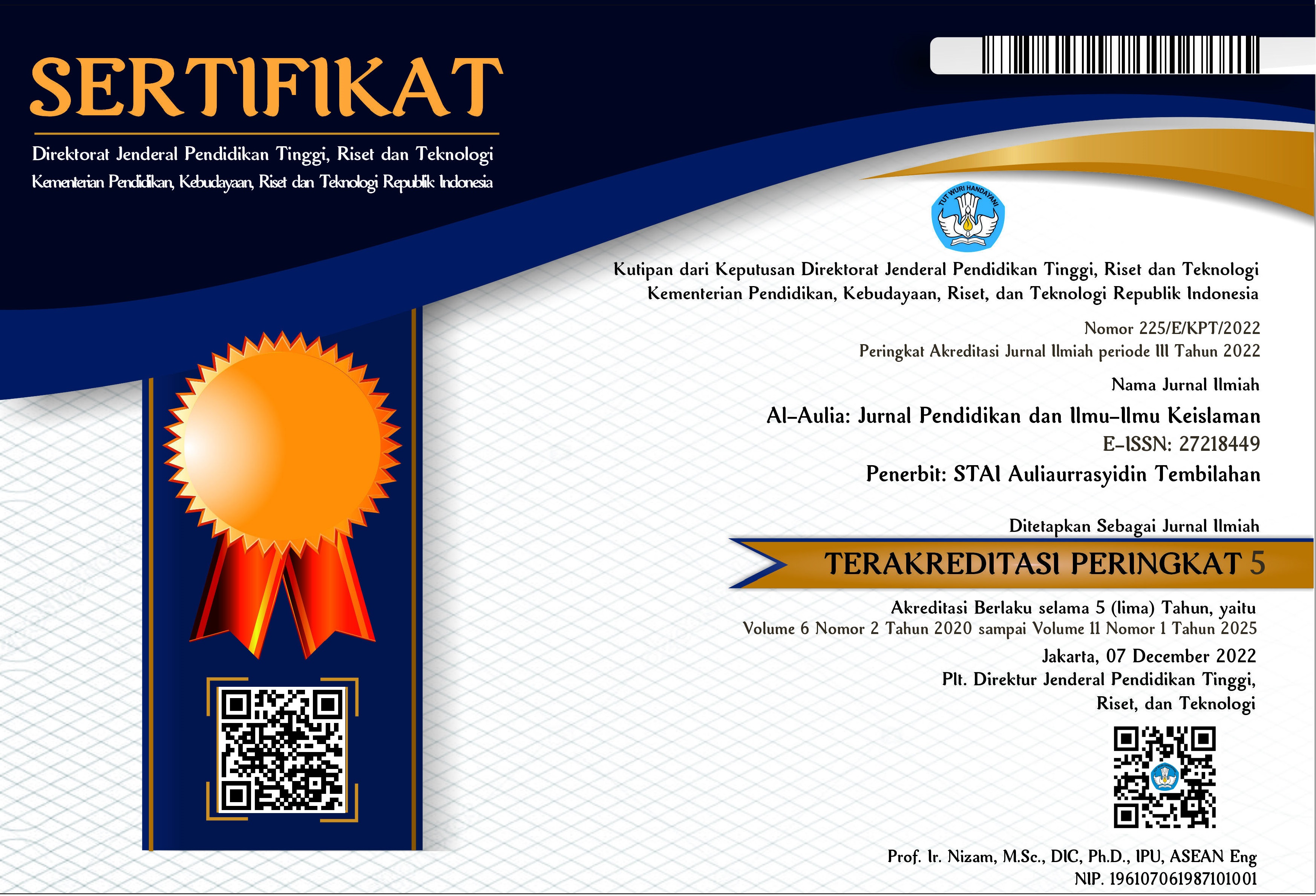Analisis Penerapan Strategi Inkuiri dalam Pelajaran Sejarah Islam Kelas 4 KMI
DOI:
https://doi.org/10.46963/aulia.v8i2.654Keywords:
Inquiry, learning, Islamic historyAbstract
One of the problems faced in the world of education today is that students are not encouraged to develop critical thinking skills to the fullest. Due to the lack of use of learning methods that can make students active and think critically. Thinking skills are one of the abilities that must be possessed by students in the 21st century. The implementation of the inquiry method in the learning process is to be able to invite students to be more active and be able to develop critical thinking skills toward the information or knowledge they have acquired. implementation of the inquiry method in developing critical thinking skills in Islamic history subjects in grade 4 KMI Gontor. The research method used is descriptive qualitative research. The research was conducted in class 4C KMI Gontor. Data collection techniques used interviews, observation, and documentation. The results of the study found that SKI teachers in grade 4 KMI Gontor could implement the inquiry method in developing students' critical thinking well. However, there are shortcomings at the stage of the inquiry method due to the limited time available. And the development of student’s critical thinking skills has begun to develop slowly and is well realized in students which are already implied at each stage of the inquiry method, but there are indicators of critical thinking skills that still need to be trained and accustomed because students have a quiet nature (introvert), shy, and lack of interest.
References
Abdullah, Usep Mudani Karim, and Abdul Azis. "Efektifitas Strategi Pembelajaran Analisis Nilai Terhadap Pengembangan Karakter Siswa Pada Mata Pelajaran Sejarah Kebudayaan Islam." Jurnal Penelitian Pendidikan Islam,[SL] 7.1 (2019): 51-62.
Abror, Sirojuddin. Implementasi Metode Inkuiri Dalam Mengembangkan Keterampilan Berfikir Kritis Peserta Didik Pada Mata Pelajaran Sejarah Kebudayaan Islam Di Ma Pembangunan Uin Jakarta. BS thesis. Jakarta: FITK UIN Syarif Hidayatullah Jakarta.
Dasima, Ai, Syaifuddin Latief, and Erni Mustakim. "Pendekatan Inkuiri Terbimbing Untuk Meningkatkan Hasil Belajar Siswa." Pedagogi: Jurnal Pendidikan Dasar 2.1 (2014).
Deraman, Fauzi. "Ilmu Takhrij Al-Hadith: Pengertian, Sejarah dan Kepentingannya." Jurnal Usuluddin 14 (2001): 55-64.
Dwiyanti, Gebi. "Model Pembelajaran Inkuiri." Tersedia: http://www. google. com/url (2011).
Fadli, Failasuf. "Penerapan Metode Inkuiri dalam Meningkatkan Keterampilan Berfikir Kritis dan Keaktifan Belajar Siswa pada Mata Pelajaran PAI di MTS Al-Amin Pekalongan." Edcomtech: Jurnal Kajian Teknologi Pendidikan 4.1 (2019): 19-28.
Hermawati, Kiki Ayu. "Implementasi Model Inkuiri dalam Pembelajaran Pendidikan Agama Islam dan Budi Pekerti: Analisis pada Materi Pembelajaran Toleransi." Jurnal Pendidikan Agama Islam Al-Thariqah 6.1 (2021): 56-72
Mas’ud, Sulthon. "Sejarah Peradaban Islam." (2014).
Noormawanti, Noormawanti. "Perspektif Ibnu Khaldun tentang Sejarah Pendidikan Islam di Indonesia." Edugama: Jurnal Kependidikan dan Sosial Keagamaan 7.2 (2021): 317-329.
Nuraini, Ani. "Perbedaan Model Pembelajaran Inkuiri Terbimbing Dengan Model Pembelajaran Inkuiri Bebas Pada Aspek Kognitif Peserta Didik (Penelitian Eksperimen Pada Materi Geografi di Kelas X SMAN 6 Cimahi)." Jurnal Geografi Gea 13.2 (2013).
Putri, Vira Nahelma, and Rahmi Wiza. "Strategi Pembelajaran Guru dalam Meningkatkan Minat Belajar Sejarah Kebudayaan Islam (SKI) pada Siswa Kelas XI di MAN 3 Pasaman Barat." Jurnal Pendidikan Tambusai 6.2 (2022): 9040-9043.
Downloads
Published
Issue
Section
License
Copyright (c) 2022 Jaziela Huwaida, Popy Miftahul Jannah

This work is licensed under a Creative Commons Attribution-ShareAlike 4.0 International License.
Authors who publish with this journal agree to the following terms:
1. Copyright on any article is retained by the author(s).
2. The author grants the journal, right of first publication with the work simultaneously licensed under a Creative Commons Attribution License that allows others to share the work with an acknowledgment of the work’s authorship and initial publication in this journal.
3. Authors are able to enter into separate, additional contractual arrangements for the non-exclusive distribution of the journal’s published version of the work (e.g., post it to an institutional repository or publish it in a book), with an acknowledgment of its initial publication in this journal.
4. Authors are permitted and encouraged to post their work online (e.g., in institutional repositories or on their website) prior to and during the submission process, as it can lead to productive exchanges, as well as earlier and greater citation of published work.
5. The article and any associated published material is distributed under the Creative Commons Attribution-ShareAlike 4.0 International License







